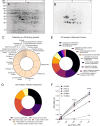Binding and cleavage of pro-urokinase by a tegument extract of Fasciola hepatica newly excysted juveniles activate the host fibrinolytic system
- PMID: 39856784
- PMCID: PMC11762853
- DOI: 10.1186/s13567-025-01449-4
Binding and cleavage of pro-urokinase by a tegument extract of Fasciola hepatica newly excysted juveniles activate the host fibrinolytic system
Abstract
Plasmin, the final product of fibrinolysis, is a broad-spectrum serine protease that degrades extracellular matrix (ECM) components, a function exploited by multiple pathogens for dissemination purposes. The trematode Fasciola hepatica is the leading cause of fasciolosis, a major disease of livestock and an emerging zoonosis in humans. Infection success depends on the ability of F. hepatica newly excysted juveniles (FhNEJ) to penetrate the host intestinal wall, a process that remains incompletely understood. We have previously shown that FhNEJ are capable of binding plasminogen (PLG), the zymogen of plasmin, on their tegument surface, which leads to plasmin generation in the presence of host-derived PLG activators and subsequent degradation of laminin, a major component of the intestinal ECM. Here, we describe the interaction between a tegument extract of FhNEJ and the precursor of the urokinase-type PLG activator (pro-u-PA). We found that F. hepatica cathepsins B3, L3, enolase and glutathione S-transferase mediate this interaction, suggesting a multifactorial or moonlighting role for these proteins. Additionally, our results revealed that the tegument of FhNEJ contains a protease that is capable of cleaving and activating pro-u-PA into its catalytically active form, which positively impacts the capacity of the parasites to generate plasmin from the host PLG. Collectively, our findings indicate that FhNEJ interact with the host fibrinolytic system at multiple levels, reinforcing the potential of targeting this interaction as a strategy to prevent FhNEJ trans-intestinal migration and infection success.
Keywords: Fasciola hepatica; fibrinolytic system; host‒parasite interactions; newly excysted juveniles; pro-urokinase.
© 2025. The Author(s).
Conflict of interest statement
Declarations. Competing interests: The authors declare that they have no competing interests.
Figures




Similar articles
-
Fasciola hepatica juveniles interact with the host fibrinolytic system as a potential early-stage invasion mechanism.PLoS Negl Trop Dis. 2023 Apr 21;17(4):e0010936. doi: 10.1371/journal.pntd.0010936. eCollection 2023 Apr. PLoS Negl Trop Dis. 2023. PMID: 37083884 Free PMC article.
-
Moonlighting on the Fasciola hepatica tegument: Enolase, a glycolytic enzyme, interacts with the extracellular matrix and fibrinolytic system of the host.PLoS Negl Trop Dis. 2024 Aug 30;18(8):e0012069. doi: 10.1371/journal.pntd.0012069. eCollection 2024 Aug. PLoS Negl Trop Dis. 2024. PMID: 39213442 Free PMC article.
-
Study of the migration of Fasciola hepatica juveniles across the intestinal barrier of the host by quantitative proteomics in an ex vivo model.PLoS Negl Trop Dis. 2022 Sep 16;16(9):e0010766. doi: 10.1371/journal.pntd.0010766. eCollection 2022 Sep. PLoS Negl Trop Dis. 2022. PMID: 36112664 Free PMC article.
-
Insights into Fasciola hepatica Juveniles: Crossing the Fasciolosis Rubicon.Trends Parasitol. 2021 Jan;37(1):35-47. doi: 10.1016/j.pt.2020.09.007. Epub 2020 Oct 13. Trends Parasitol. 2021. PMID: 33067132 Review.
-
Exploitation of plasmin(ogen) by bacterial pathogens of veterinary significance.Vet Microbiol. 2015 Jul 9;178(1-2):1-13. doi: 10.1016/j.vetmic.2015.04.008. Epub 2015 Apr 17. Vet Microbiol. 2015. PMID: 25937317 Review.
References
-
- González-Miguel J, Siles-Lucas M, Kartashev V, Morchón R, Simón F (2016) Plasmin in parasitic chronic infections: friend or foe? Trends Parasitol 32:325–335 - PubMed
-
- Figuera L, Gómez-Arreaza A, Avilán L (2013) Parasitism in optima forma: exploiting the host fibrinolytic system for invasion. Acta Trop 128:116–123 - PubMed
-
- Cesarman-Maus G, Hajjar KA (2005) Molecular mechanisms of fibrinolysis. Br J Haematol 129:307–321 - PubMed
MeSH terms
Substances
Grants and funding
LinkOut - more resources
Full Text Sources
Miscellaneous

